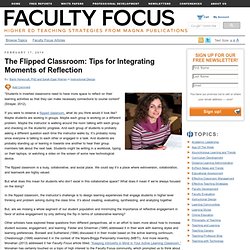

Classe inversée. La méthode inversée en français. ATTENTION Licence creative Commons Licence sélectionnée Attribution - Pas d’Utilisation Commerciale - Partage dans les Mêmes Conditions 4.0 International. Flipped/online classroom. Popplet : La pédagogie inversée. Classe Inversée - Libérons l'éducation. La pédagogie inversée. Faire ses premiers pas vers la classe inversée. Un dossier conjoint Infobourg – Carrefour Éducation Peut-être avez-vous entendu parler dernièrement de la fameuse dynamique de « classe inversée »?

Elle semble être sur toutes les lèvres! Parmi les enseignants qui l’ont expérimentée, certains ne peuvent plus s’en passer et y voient des avantages énormes, notamment grâce aux nouvelles possibilités de personnalisation de l’enseignement entraînée par l’augmentation du temps disponible pour les élèves. Mais tout d’abord, qu’est-ce que la classe inversée? C’est une façon d’organiser le temps de classe de sorte que la partie magistrale du cours est dispensée de façon électronique (capsules vidéo, lectures personnelles, visites virtuelles, etc.) et le temps de classe est consacré au travail d’équipe, aux discussions et aux activités d’apprentissage actives. Ce dossier conjoint de Carrefour Éducation et d’Infobourg propose de faire le tour de la question et de prendre connaissance de l’expérience de certains enseignants.
Plan du dossier : 1. 2. Classe inversée. La classe inversée. Pédagogie inversée. Classe inversée. Flipping the Class. Pédagogie inversée. The Flipped Classroom: Tips for Integrating Moments of Reflection. February 17, 2014 By: Barbi Honeycutt, PhD and Sarah Egan Warren in Instructional Design “Students in inverted classrooms need to have more space to reflect on their learning activities so that they can make necessary connections to course content” (Strayer, 2012).

If you were to observe a flipped classroom, what do you think would it look like? Maybe students are working in groups. Maybe each group is working on a different problem. The flipped classroom is a busy, collaborative, and social place. But what does this mean for students who don’t excel in this collaborative space? In the flipped classroom, the instructor’s challenge is to design learning experiences that engage students in higher level thinking and problem solving during the class time. But, are we missing a whole segment of our student population and minimizing the importance of reflective engagement in favor of active engagement by only defining the flip in terms of collaborative learning?
So, what can we do? Monahan, N. Five Best Practices for the Flipped Classroom. Ok, I'll be honest.

I get very nervous when I hear education reformists and politicians tout how "incredible" the flipped-classroom model, or how it will "solve" many of the problems of education. It doesn't solve anything. It is a great first step in reframing the role of the teacher in the classroom. It fosters the "guide on the side" mentality and role, rather than that of the "sage of the stage. " It helps move a classroom culture towards student construction of knowledge rather than the teacher having to tell the knowledge to students. It also creates the opportunity for differentiated roles to meet the needs of students through a variety of instructional activities. 1) Need to Know How are you creating a need to know the content that is recorded?
2) Engaging Models.